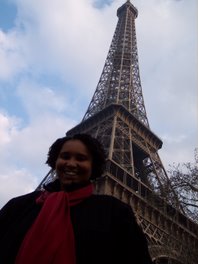 Self-guided discovery / Ethnic neighborhood report
Self-guided discovery / Ethnic neighborhood report(oral and written) (10%)
In groups of three or four students maximum, choose one cluster of addresses below and pick three addresses to visit within the cluster. The places you visit may be large or small, the employees and / or volunteers may or may not speak English, but this is part of the discovery activity—to gather information in an environment with which you are totally unfamiliar. If you do not have a Paris street guide, there is a map of the immediate area at each metro stop which will allow you to find the streets indicated. At each location, look for written materials to take along with you and do not be afraid to ask questions or to explain to those on-site what the goal of your course is. You will write up your findings in TWO pages and your group will also present your discoveries (and adventures) to the class on January 6th at 4 p.m.
Cluster 1: The Maghreb (North Africa)
Centre Culturel Algérien (Algerian Cultural Center)
171 rue de la Croix-Nivert, metro : Felix-Faure, Mon. – Sat. 9-17h30 or evenings with special exhibits
Nina Bazar
35 boulevard de Belleville, metro : Belleville, Tues – Sat. 9h30 to 19h30 (Arab market)
Deux mille et une nuits
13 rue des Francs-Bourgeois, metro : Saint-Paul, everyday from 11-19h30 (upscale Arab clothing/ goods—Moroccan influence)
Cluster 2 : The Mashrek: representative countries: Egypt, Lebanon, and Syria (if you choose this cluster, do not make all three visits to Egyptian sites alone)
Egypt :
Centre Culturel d’Egypte (Egyptian Cultural Center)
111 boulevard Saint-Michel, metro : Luxembourg, Mon. – Fri. 10-19h
Quartier de la Foire au Caire
Place, passage, et rue du Caire, rue d’Aboukir, rue de Domiette, metro: Réamur-Sebastopol, weekdays and Saturday from 11-2 p.m.
(entire Eygptian-influenced neighborhood from 1798—although the neighborhood is no longer Egyptian, it will not take you long to discover its Egyptian roots—in particular, look at the facade at 2, place du Caire and enter the passageway)
Maison d’Egypte (Egypt House)
132 ave du Maine, metro: Gaité, Mon. – Sat. 10-2 and 3-7
Lebanon :
Eglise Maronite Notre-Dame du Liban
15-17 rue d’Ulm, metro : Luxembourg
Syria :
Centre Culturel arabe syrien (Arab-Syrian Cultural Center)
12 rue de Tourville, metro : Ecole Militaire, Mon. – Thurs. 10-6, Friday, 10-3
Cluster 3: Kurdistan, Turkey, and Armenia :
Kurdistan :
Institut Kurde (Kurdish Institute)
106 rue LaFayette, back courtyard, metro : Poissonière, Mon-Fri. 9h30-6:30 and Sat. 2-6.
Centre culturel kurde Ahmet Kaya
16 rue d’Enghien, metro : Strasbourg-Sain-Denis, everyday 10-19h
Turkey:
Eglise du Saint-Esprit
186 avenue Daumesnil, metro: Daumesnil (replica of the Aya Sofia mosque in Istanbul)
Ottomania
14 rue Charles V, metro: Saint-Paul, Tues-Fri. 11-19h, Saturday 14h-19h (Turkish bazaar)
Armenia:
Maison de la culture arménienne (House of Armenian Culture)
17 rue Bleue, metro : Cadet (various activities and hours)
Cluster 4: Iran:
Centre Culturel Pouya
48 bis quai de Jemmapes, metro: République, everyday from 10-22h (independent, secular center for Persian arts)
Centre culturel iranien (Iranian cultural center)
6 rue Jean-Béart, metro : Saint-Sulpice, Mon.-Sat. 15h-19h
Artisanat d’Iran (Iranian artistic goods)
28 rue Gay-Lussac, metro : Luxembourg, Mon-Sat. 10h-19h30.
Cluster 5: Sub-Saharan Africa :
Notre Dame des Buttes-Chaumont
80 rue de Meaux, metro : Bolivar, every day with special Kimbangu services on Sundays from 15h-17h (Kimbangu is an African Christian group originating from Congo-Kinshasa and Angola)
As-Art
3 Passage du Grand-cerf, Metro: Etienne Marcel, Tues. – Sat. 11h30-19h30 (African furniture and housewares)
CSAO
3 (boutique) and 15 (art gallery) rue Elzévir, metro :Saint-Paul, Mon.-Sat. 11-19h and Sunday 14-19 (boutique only)
Espace Reine de Saba (Cultural Center of Yemen and Ethiopia)
30 rue Pradier, metro: Buttes-Chaumont or Pyrénées, Tues. thru Sunday 14h-19h, opens at 11 on Saturdays
Maison d’Ethiopie (Ethiopia House)
19 rue Copreaux, Metro: Volontaires, Tues. to Sun. From 11 to 19h
Cluster 6 : Tibet :
Bureau du Tibet et Maison du Tibet (Official office of Tibetan government in exile and Culture center)
84 boulevard Adolphe Pinard, metro : Malakoff-Plateau de Vanves
La Maison de l’Indochine (Cultural Center for Vietnam, Laos, and Cambodia)
76 rue Bonaparte, Metro : Saint-Sulpice, Mon. to Sat. from 10-19h
Galerie de la Maison du Viêt-nam (Vietnamese art market)
28 rue des Bernardins, metro : Maubert-Mutualité, Mon. to Sat. 11-19h
Cluster 7 : India, Sri Lanka, and Pakistan :
Sri Manika Vinayakar Alayam (Very friendly Hindu temple—you must leave shoes at the door)
72 rue du Philippe-de-Girard, metro : Max Dormoy, everyday from 9h30-20h30
Centre Mandapa (Indian cultural center)
6 rue Wurtz, metro : Glacière, Mon. to Sat. 11-19h
New Shamina Super Market (Indian bazaar)
184 rue du Faubourg Saint-Denis, metro : La Chapelle, Mon-Sat. 10h-20h.
VT Cash and Carry (Indian supermarket)
15 rue Cail, metro: La Chapelle, 9-9 p.m everyday but Monday
Ganesha Corner (Indian and Sri Lankan bakery, snackshop, and restaurant)
16 rue Perdonnet, Metro: La Chapelle
Note : The Pakistani neighborhoods can be found in the Rue de Jarry (metro: Gare de l’Est) and the Passage Brady (metro : Strasbourg Saint-Denis). You may also choose one or both of these sites for this cluster.







